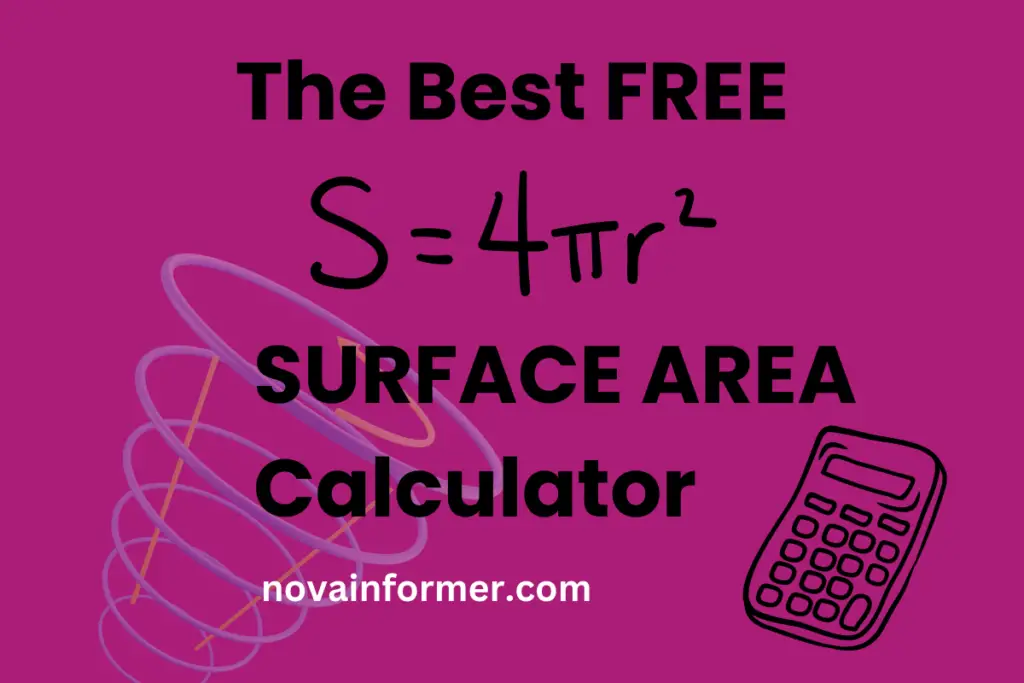Want to calculate surface area? Our free surface area calculator is exactly what you need. Calculate the surface areas of triangles, circles, and rectangles.
A = L * l
A = π r ²
π=3.14; r = radius
A = (1/2) * b * h
A = a²
a = Side length
Key Takeaways:
- Surface area is the measure of how much space the surface of a three-dimensional object occupies.
- From simple 2D shapes to complex 3D structures, understanding surface area is crucial in various fields.
Introduction to Surface Area
Welcome to the fascinating world of surface area, where shapes come to life in three dimensions.
In simple terms, surface area is like the superhero cape of geometry—it tells you how much space the surface of an object covers.
Let’s dive into the basics and uncover the mysteries behind this essential concept.
Basic Concepts of Surface Area
Area 101: Two-Dimensional Shapes
Surface area’s journey begins with understanding area itself. Imagine a superhero shield, like Captain America’s.
Now think of it as a square or rectangle; that’s the area. Easy, right?
Calculating Surface Area of 2D Shapes
Squares and Rectangles: A Superhero’s Shield
| Shape | Formula |
|---|---|
| Square | Area = a2, Surface Area = 4a |
| Rectangle | Area = l x w, Surface Area = 2lw + 2lh + 2wh |
Surface Area of 3D Shapes
The Cube: More Than Meets the Eye
| Shape | Formula |
|---|---|
| Cube | Surface Area = 6a2 |
How to Use this Surface Area Calculator
Welcome to the surface area calculator—an intuitive tool to help you swiftly calculate the surface area of various shapes.
Whether you’re dealing with rectangles, circles, triangles, or cubes, we’ve got you covered. Here’s a simple guide on how to make the most of this calculator:
1. Surface Area of a Rectangle
- Input Values: Enter the height and width of your rectangle in centimeters.
- Click Calculate: Hit the “Calculate” button to instantly find the surface area.
- Clear Values: If you want to start fresh, click “Clear” to reset the calculator.
2. Surface Area of a Circle
- Input Values: Provide the radius of your circle in centimeters.
- Click Calculate: Tap the “Calculate” button to get the surface area in a flash.
- Clear Values: Ready for a new calculation? Hit “Clear” to wipe the slate clean.
3. Surface Area of a Triangle
- Input Values: Enter the height and base of your triangle in centimeters.
- Click Calculate: Simply press “Calculate” to see the surface area magically appear.
- Clear Values: Starting a new calculation? Click “Clear” and you’re good to go.
4. Surface Area of a Cube
- Input Values: Input the side length of your cube in centimeters.
- Click Calculate: Hit “Calculate” to unveil the surface area effortlessly.
- Clear Values: Want a fresh start? Click “Clear” to reset the calculator for the next calculation.
Remember, each section has its dedicated input fields and buttons, making it easy to focus on the specific shape you’re working with.
Dive in, explore, and let this calculator simplify your surface area calculations! 💡📏
Have a question or a different shape in mind? Drop it in the comments, and let’s navigate the world of surface area together! 🔍💬
Real-life Applications of Surface Area
Ever wondered how architects design those awe-inspiring buildings? 🏰 Surface area is the secret sauce.
From constructing skyscrapers to engineering everyday items, its applications are boundless.
The adventure into surface area is just beginning.
What’s your favorite shape so far? Drop your answers in the comments below, and let’s keep this conversation rolling. 👇
PART 2
Composite Shapes and Surface Area
In the world of surface area, not all shapes are straightforward. Sometimes, you encounter objects that resemble a mishmash of squares, triangles, and circles.
Fear not—this is where the concept of composite shapes comes to the rescue.
Composite Shapes Unraveled
Imagine a cereal box; it’s not just a rectangular prism, but it also has flaps and folds.
Calculating the surface area of such objects requires breaking them down into familiar shapes, finding their individual areas, and then summing them up.
Composite Shape Formula
Surface Area = Sum of Individual Areas
This formula acts as your magic wand to navigate through the complexities of composite shapes. It’s like solving a puzzle where each piece contributes to the overall picture.
Surface Area in Geometry and Trigonometry
Trigonometry’s Role in Surface Area
Hold on tight as we introduce the superhero duo of surface area and trigonometry. When dealing with slanted sides or curves, trigonometric functions come into play, akin to Captain America calculating the area of his shield when flinging it through the air.
Trigonometric Functions and Surface Area
Surface Area = Base Area + Lateral Area
This formula brings together the base area (like the shield’s front) and the lateral area (the curved sides). Together, they provide a comprehensive view of the entire surface.
Surface Area in Science and Engineering
Now, let’s step into the laboratory and the engineering workshop, where surface area is not just a mathematical concept but a practical tool.
Applications in Physics and Chemistry
In the realm of science, surface area is a key player. Whether it’s understanding chemical reactions or designing materials with specific properties, scientists rely on surface area calculations.
Engineering Marvels
Here, surface area takes center stage in the design of objects like cylinders and spheres. The formulas for these shapes ensure that engineers create structures with optimal efficiency and aesthetics.
| Object | Surface Area Formula |
|---|---|
| Cylinder | Surface Area = 2π r2 + 2π rh |
| Sphere | Surface Area = 4π r2 |
Optimizing Surface Area: Where Art Meets Mathematics
Maximizing or Minimizing Surface Area
Imagine you have a sheet of paper, and you want to create the most intricate origami masterpiece. Surface area optimization is your secret sauce, helping you maximize or minimize the area based on your creative or practical goals.
Are you ready to take your surface area skills to the next level?
Which aspect intrigues you the most—composite shapes, trigonometry, or the real-world applications in science and engineering? Share your thoughts in the comments, and let’s explore the wonders of surface area together. 🔍🚀
PART 3
Frequently Asked Questions (FAQs)
How do you find the surface area of complex shapes?
Surface area calculations for complex shapes involve breaking them down into simpler components, finding the surface area of each part, and summing them up. Think of it like solving a puzzle—each piece contributes to the overall solution.
Can you explain why trigonometry is used in surface area calculations?
Certainly! Trigonometry becomes essential when dealing with slanted or curved surfaces. It helps break down these surfaces into components that are easier to calculate, providing a comprehensive view of the entire surface area.
Are there real-life applications of surface area beyond mathematics?
Absolutely! Surface area plays a crucial role in various fields. Architects use it in designing buildings, chemists rely on it for understanding reactions, and engineers apply it to optimize structures for efficiency and aesthetics.
Is there a shortcut for calculating surface area?
While there’s no one-size-fits-all shortcut, certain shapes have specific formulas that can simplify calculations. For instance, the surface area of a cube is six times the area of one of its faces.
How can surface area be optimized in practical scenarios?
Surface area optimization involves adjusting the dimensions of an object to achieve specific goals. Whether you’re an artist crafting a sculpture or an engineer designing a space-efficient structure, understanding surface area helps you make informed decisions.
Are there any online tools for visualizing 3D shapes and surface area?
Absolutely! Embrace the digital era with interactive tools that allow you to visualize and manipulate 3D shapes. These tools enhance your understanding of surface area concepts, making learning both fun and interactive.
Can you provide examples of surface area in daily life?
Certainly! From wrapping gifts efficiently to determining how much paint you need for a room, surface area influences various aspects of our daily lives. It’s the unsung hero behind practical problem-solving.
How does surface area relate to chemistry?
In chemistry, surface area affects reaction rates. Finely powdered substances have more surface area, allowing for increased interaction with other substances, leading to faster reactions.
In Conclusion: Embrace the World of Surface Area
Congratulations, surface area explorer! 🌐🎉 You’ve journeyed through the basics, tackled composite shapes, dabbled in trigonometry, and witnessed the real-world applications in science and engineering.
As we conclude this adventure, remember that surface area isn’t just a mathematical concept—it’s a superhero cape guiding architects, chemists, and engineers in shaping our world.
Let’s keep the conversation alive! What’s your favorite application of surface area?
Any questions or thoughts? Drop them in the comments below, and let’s continue unraveling the mysteries of surface area together! 🔍💬
License:
by Abdo Jara (https://codepen.io/abdo-jara/pen/PoPyPRN)



